Bibliometric Maps of BIM and BIM in Universities: A Comparative Analysis
Abstract
:1. Introduction
2. Research Methodology
2.1. Data Collection
2.2. Community Detection
3. Results and Discussion
3.1. Evolution of the Number of Publication Over the Years
3.2. Distribution of Output in Subject Categories
3.3. Types of Publications
3.4. Distribution by Countries and Institutions
3.5. Relationships between Countries
3.6. Keyword Analysis
4. Discussion
5. Conclusions
Author Contributions
Funding
Conflicts of Interest
References
- Eastman, C.; Teicholz, P.; Sacks, R.; Liston, K. BIM Handbook: A Guide to Building Information Modeling for Owners, Managers, Designers, Engineers and Contractors; John Wiley & Sons: Hoboken, NJ, USA, 2011. [Google Scholar]
- Hergunsel, M.F. Benefits of Building Information Modeling for Construction Managers and BIM Based Scheduling. Master’s Thesis, Worcester Polytechnic Institute, Worcester, MA, USA, 2011. [Google Scholar]
- Rynne, C. Industrial Ireland 1750–1930: An Archaeology; Collins Press: New York, NY, USA, 2006. [Google Scholar]
- Sturdevant, J.R.; Bayne, S.C.; Heymann, H.O. Margin gap size of ceramic inlays using second—Generation CAD/CAM equipment. J. Esthet. Restor. Dent. 1999, 11, 206–214. [Google Scholar] [CrossRef]
- Goodacre, C.J.; Garbacea, A.; Naylor, W.P.; Daher, T.; Marchack, C.B.; Lowry, J. CAD/CAM fabricated complete dentures: Concepts and clinical methods of obtaining required morphological data. J. Prosthet. Dent. 2012, 107, 34–46. [Google Scholar] [CrossRef]
- Engelbart, C. Augmenting Human Intellect: A Conceptual Framework; Doug Engelbart Institute: Menlo Park, CA, USA, 1962. [Google Scholar]
- Eastman, C. The use of computers instead of drawings in building design. AIA J. 1975, 63, 46–50. [Google Scholar]
- Eastman, C.; Henrion, M. Glide: A Language for Design Information Systems. In ACM SIGGRAPH Computer Graphics; ACM: New York, NY, USA, 1977. [Google Scholar]
- Aish, R. Three-dimensional input and visualization. In Computer-Aided Architectural Design Futures; Butterworth-Heinemann: Oxford, UK, 1986; pp. 68–84. [Google Scholar]
- Van Nederveen, G.A.; Tolman, F.P. Modeling multiple views on buildings. Autom. Constr. 1992, 1, 215–224. [Google Scholar] [CrossRef]
- Vysotskiy, A.; Makarov, S.; Zolotova, J.; Tuchkevich, E. Features of BIM implementation using autodesk software. Procedia Eng. 2015, 117, 1143–1152. [Google Scholar] [CrossRef]
- Ulmanis, J. CASE 6: Graphisoft: The Architecture of International Growth; Entrepreneurial Icebreakers; Palgrave Macmillan: London, UK, 2015; pp. 193–209. [Google Scholar]
- Mueller, V.; Smith, M. Generative Components and Smartgeometry: Situated Software Development. Inside Smartgeometry Expand. Archit. Possibilities Comput. Des. 2013, 2013, 142–153. [Google Scholar]
- Watson, A. Digital buildings–Challenges and opportunities. Adv. Eng. Inform. 2011, 25, 573–581. [Google Scholar] [CrossRef]
- Poole, M.; Shvartzberg, M. (Eds.) The Politics of Parametricism: Digital Technologies in Architecture; Bloomsbury Publishing: London, UK, 2015. [Google Scholar]
- Wu, P.; Wang, J.; Wang, X. A critical review of the use of 3-D printing in the construction industry. Autom. Constr. 2016, 68, 21–31. [Google Scholar] [CrossRef] [Green Version]
- Macher, H.; Landes, T.; Grussenmeyer, P. From point clouds to building information models: 3D semi-automatic reconstruction of indoors of existing buildings. Appl. Sci. 2017, 7, 1030. [Google Scholar] [CrossRef]
- Ochmann, S.; Vock, R.; Klein, R. Automatic reconstruction of fully volumetric 3D building models from oriented point clouds. ISPRS J. Photogramm. Remote Sens. 2019, 151, 251–262. [Google Scholar] [CrossRef] [Green Version]
- Wang, C.; Cho, Y.K.; Kim, C. Automatic BIM component extraction from point clouds of existing buildings for sustainability applications. Autom. Constr. 2015, 56, 1–13. [Google Scholar] [CrossRef]
- Teizer, J.; Wolf, M.; Golovina, O.; Perschewski, M.; Propach, M.; Neges, M.; König, M. Internet of things (IoT) for integrating environmental and localization data in building information modeling (BIM). In Proceedings of the International Symposium on Automation and Robotics in Construction (ISARC), Vilnius Gediminas Technical University, Department of Construction Economics & Property, Taipei, Taiwan, 28 June–1 July 2017; Volume 34. [Google Scholar]
- Pasini, D.; Ventura, S.M.; Rinaldi, S.; Bellagente, P.; Flammini, A.; Ciribini, A.L.C. Exploiting Internet of Things and building information modeling framework for management of cognitive buildings. In Proceedings of the 2016 IEEE International Smart Cities Conference (ISC2), Trento, Italy, 12–15 September 2016; Volumes 1–6. [Google Scholar]
- Deng, Y.; Cheng, J.C.P.; Anumba, C. Mapping between BIM and 3D GIS in different levels of detail using schema mediation and instance comparison. Autom. Constr. 2016, 67, 1–21. [Google Scholar] [CrossRef]
- Liu, X.; Wang, X.; Wright, G.; Cheng, J.C.P.; Li, X.; Liu, R. A state-of-the-art review on the integration of Building Information Modeling (BIM) and Geographic Information System (GIS). ISPRS Int. J. Geo Inf. 2017, 6, 53. [Google Scholar] [CrossRef]
- Irizarry, J.; Karan, E.P.; Jalaei, F. Integrating BIM and GIS to improve the visual monitoring of construction supply chain management. Autom. Constr. 2013, 31, 241–254. [Google Scholar] [CrossRef]
- Li, C.Z.; Hong, J.; Xue, F.; Shen, G.Q.; Xu, X.; Mok, M.K. Schedule risks in prefabrication housing production in Hong Kong: A social network analysis. J. Clean. Prod. 2016, 134, 482–494. [Google Scholar] [CrossRef]
- Jin, Z.; Gambatese, J.; Liu, D.; Dharmapalan, V. Risk Assessment in 4D Building Information Modeling for Multistory Buildings. In Proceedings of the Joint CIB W099 and TG59 Conference, Coping with the Complexity of Safety, Health, and Wellbeing in Construction, Salvador, Brazil, 1–3 August 2018; pp. 84–92. [Google Scholar]
- McGlinn, K.; Wagner, A.; Pauwels, P.; Bonsma, P.; Kelly, P.; O’Sullivan, D. Interlinking geospatial and building geometry with existing and developing standards on the web. Autom. Constr. 2019, 103, 235–250. [Google Scholar] [CrossRef]
- Mishchenko, E.S.; Monastyrev, P.V.; Evdokimtsev, O.V. Improving the Quality of Training in Building Information Modeling. In International Conference on Interactive Collaborative Learning; Springer: Cham, Switzerland, 2018; pp. 453–459. [Google Scholar]
- Alwan, Z.; Jones, P.; Holgate, P. Strategic sustainable development in the UK construction industry, through the framework for strategic sustainable development, using Building Information Modeling. J. Clean. Prod. 2017, 140, 349–358. [Google Scholar] [CrossRef]
- Bradley, A.; Li, H.; Lark, R.; Dunn, S. BIM for infrastructure: An overall review and constructor perspective. Autom. Constr. 2016, 71, 139–152. [Google Scholar] [CrossRef]
- Kassem, M.; Kelly, G.; Dawood, N.; Serginson, M.; Lockley, S. BIM in facilities management applications: A case study of a large university complex. Built Environ. Proj. Asset Manag. 2015, 5, 261–277. [Google Scholar] [CrossRef]
- Fan, S.L.; Chong, H.Y.; Liao, P.C.; Lee, C.Y. Latent Provisions for Building Information Modeling (BIM) Contracts: A Social Network Analysis Approach. KSCE J. Civ. Eng. 2019, 23, 1427–1435. [Google Scholar] [CrossRef] [Green Version]
- Badrinath, A.C.; Chang, Y.T.; Hsieh, S.H. A review of tertiary BIM education for advanced engineering communication with visualization. Vis. Eng. 2016, 4, 9. [Google Scholar] [CrossRef]
- Fan, S.L.; Lee, C.Y.; Chong, H.Y.; Skibniewski, M.J. A critical review of legal issues and solutions associated with building information modeling. Technol. Econ. Dev. Econ. 2018, 24, 2098–2130. [Google Scholar] [CrossRef]
- Lee, C.Y.; Chong, H.Y.; Wang, X. Enhancing BIM performance in EPC projects through integrative trust-based functional contracting model. J. Constr. Eng. Manag. 2018, 144, 06018002. [Google Scholar] [CrossRef]
- Nawari, N.O. BIM Data Exchange Standard for Hydro-Supported Structures. J. Archit. Eng. 2019, 25, 04019015. [Google Scholar] [CrossRef]
- Manzano-Agugliaro, F.; Calero, M.S.; Perea-Moreno, A.J.; De San Antonio Gomez, C. Ensayo de segregación en cimentaciones para la estructura soporte de aerogeneradores off-shore hechas por vertido en caída libre. DYNA 2018, 93, 221–227. [Google Scholar] [CrossRef]
- Nawari, N.O.; Ravindran, S. Blockchain and the built environment: Potentials and limitations. J. Build. Eng. 2019, 25, 100832. [Google Scholar] [CrossRef]
- Nawari, N.O.; Ravindran, S. Blockchain technology and BIM process: Review and potential applications. J. Inf. Technol. Constr. 2019, 24, 209–238. [Google Scholar]
- Salmerón-Manzano, E.; Manzano-Agugliaro, F. The Role of Smart Contracts in Sustainability: Worldwide Research Trends. Sustainability 2019, 11, 3049. [Google Scholar] [CrossRef]
- Maskil-Leitan, R.; Reychav, I. BIM’s social role in building energy modeling. Clean Technol. Environ. Policy 2019, 21, 307–338. [Google Scholar] [CrossRef]
- Gao, H.; Koch, C.; Wu, Y. Building information modeling based building energy modeling: A review. Appl. Energy 2019, 238, 320–343. [Google Scholar] [CrossRef]
- Abanda, F.H.; Byers, L. An investigation of the impact of building orientation on energy consumption in a domestic building using emerging BIM (Building Information Modeling). Energy 2016, 97, 517–527. [Google Scholar] [CrossRef]
- Zanni, M.A.; Soetanto, R.; Ruikar, K. Towards a BIM-enabled sustainable building design process: Roles, responsibilities, and requirements. Archit. Eng. Des. Manag. 2017, 13, 101–129. [Google Scholar] [CrossRef]
- Bouchlaghem, D.; Shang, H.; Anumba, C.J.; Cen, M.; Miles, J.; Taylor, M. ICT-enabled collaborative working environment for concurrent conceptual design. Archit. Eng. Des. Manag. 2005, 1, 261–280. [Google Scholar] [CrossRef]
- Chong, H.Y.; Lee, C.Y.; Wang, X. A mixed review of the adoption of Building Information Modeling (BIM) for sustainability. J. Clean. Prod. 2017, 142, 4114–4126. [Google Scholar] [CrossRef]
- Zanni, M.A.; Soetanto, R.; Ruikar, K. Defining the sustainable building design process: Methods for BIM execution planning in the UK. Int. J. Energy Sector Manag. 2014, 8, 562–587. [Google Scholar] [CrossRef]
- Crawley, D.B.; Hand, J.W.; Kummert, M.; Griffith, B.T. Contrasting the capabilities of building energy performance simulation programs. Build. Environ. 2008, 43, 661–673. [Google Scholar] [CrossRef] [Green Version]
- Crawley, E.; Malmqvist, J.; Ostlund, S.; Brodeur, D.; Edstrom, K. Rethinking engineering education. CDIO Approach 2007, 302, 60–62. [Google Scholar]
- Li, X.; Wu, P.; Shen, G.Q.; Wang, X.; Teng, Y. Mapping the knowledge domains of Building Information Modeling (BIM): A bibliometric approach. Autom. Constr. 2017, 84, 195–206. [Google Scholar] [CrossRef]
- Zhao, X. A scientometric review of global BIM research: Analysis and visualization. Autom. Constr. 2017, 80, 37–47. [Google Scholar] [CrossRef]
- Olawumi, T.O.; Chan, D.W.; Wong, J.K. Evolution in the intellectual structure of BIM research: A bibliometric analysis. J. Civ. Eng. Manag. 2017, 23, 1060–1081. [Google Scholar] [CrossRef]
- Oraee, M.; Hosseini, M.R.; Papadonikolaki, E.; Palliyaguru, R.; Arashpour, M. Collaboration in BIM-based construction networks: A bibliometric-qualitative literature review. Int. J. Proj. Manag. 2017, 35, 1288–1301. [Google Scholar] [CrossRef]
- Wong, J.K.W.; Zhou, J. Enhancing environmental sustainability over building life cycles through green BIM: A review. Autom. Constr. 2015, 57, 156–165. [Google Scholar] [CrossRef]
- Aghaei Chadegani, A.; Salehi, H.; Yunus, M.M.; Farhadi, H.; Fooladi, M.; Farhadi, M.; Ale Ebrahim, N. A comparison between two main academic literature collections: Web of science and scopus databases. Asian Soc. Sci. 2013, 9, 18–26. [Google Scholar] [CrossRef]
- Bryde, D.; Broquetas, M.; Volm, J.M. The project benefits of building information modeling (BIM). Int. J. Proj. Manag. 2013, 31, 971–980. [Google Scholar] [CrossRef]
- Becerik-Gerber, B.; Jazizadeh, F.; Li, N.; Calis, G. Application areas and data requirements for BIM-enabled facilities management. J. Constr. Eng. Manag. 2011, 138, 431–442. [Google Scholar] [CrossRef]
- Singh, V.; Gu, N.; Wang, X. A theoretical framework of a BIM-based multi-disciplinary collaboration platform. Autom. Constr. 2011, 20, 134–144. [Google Scholar] [CrossRef]
- Azhar, S.; Khalfan, M.; Maqsood, T. Building information modeling (BIM): Now and beyond. Constr. Econ. Build. 2012, 12, 15–28. [Google Scholar] [CrossRef]
- Succar, B. Building information modeling framework: A research and delivery foundation for industry stakeholders. Autom. Constr. 2009, 18, 357–375. [Google Scholar] [CrossRef]
- Li, C.Z.; Xue, F.; Li, X.; Hong, J.; Shen, G.Q. An Internet of Things-enabled BIM platform for on-site assembly services in prefabricated construction. Autom. Constr. 2018, 89, 146–161. [Google Scholar] [CrossRef]
- Howard, R.; Björk, B.C. Building information modeling–Experts’ views on standardisation and industry deployment. Adv. Eng. Inform. 2008, 22, 271–280. [Google Scholar] [CrossRef]
- Azhar, S. Building information modeling (BIM): Trends, benefits, risks, and challenges for the AEC industry. Leadersh. Manag. Eng. 2011, 11, 241–252. [Google Scholar] [CrossRef]
- Kang, T.W.; Hong, C.H. A study on software architecture for effective BIM/GIS-based facility management data integration. Autom. Constr. 2015, 54, 25–38. [Google Scholar] [CrossRef]
- Ning, X.; Wang, Y. 3D reconstruction of architecture appearance: A survey. Comput. Inf. Syst. 2013, 9, 3837–3848. [Google Scholar]
- Kim, J.L. Use of BIM for effective visualization teaching approach in construction education. J. Prof. Issues Eng. Educ. Pract. 2011, 138, 214–223. [Google Scholar] [CrossRef]
- Castro-Garcia, M.; Perez-Romero, A.M.; León-Bonillo, M.J.; Manzano-Agugliaro, F. Developing Topographic Surveying Software to Train Civil Engineers. J. Prof. Issues Eng. Educ. Pract. 2016, 143, 04016013. [Google Scholar] [CrossRef]
- Volk, R.; Stengel, J.; Schultmann, F. Building Information Modeling (BIM) for existing buildings—Literature review and future needs. Autom. Constr. 2014, 38, 109–127. [Google Scholar] [CrossRef]
- Migilinskas, D.; Popov, V.; Juocevicius, V.; Ustinovichius, L. The benefits, obstacles and problems of practical BIM implementation. Procedia Eng. 2013, 57, 767–774. [Google Scholar] [CrossRef]
- Motawa, I.; Carter, K. Sustainable BIM-based evaluation of buildings. Procedia Soc. Behav. Sci. 2013, 74, 419–428. [Google Scholar] [CrossRef]
- Habibi, S. The promise of BIM for improving building performance. Energy Build. 2017, 153, 525–548. [Google Scholar] [CrossRef]
- AlFaris, F.; Juaidi, A.; Manzano-Agugliaro, F. Energy retrofit strategies for housing sector in the arid climate. Energy Build. 2016, 131, 158–171. [Google Scholar] [CrossRef]
- Wong, K.D.; Fan, Q. Building information modeling (BIM) for sustainable building design. Facilities 2013, 31, 138–157. [Google Scholar] [CrossRef]
- Ku, K.; Taiebat, M. BIM experiences and expectations: The constructors’ perspective. Int. J. Constr. Educ. Res. 2011, 7, 175–197. [Google Scholar] [CrossRef]
- Fridrich, J.; Kubečka, K. BIM–the process of modern civil engineering in higher education. Procedia Soc. Behav. Sci. 2014, 141, 763–767. [Google Scholar] [CrossRef]
- Cheng, J.C.; Ma, L.Y. A BIM-based system for demolition and renovation waste estimation and planning. Waste Manag. 2013, 33, 1539–1551. [Google Scholar] [CrossRef]
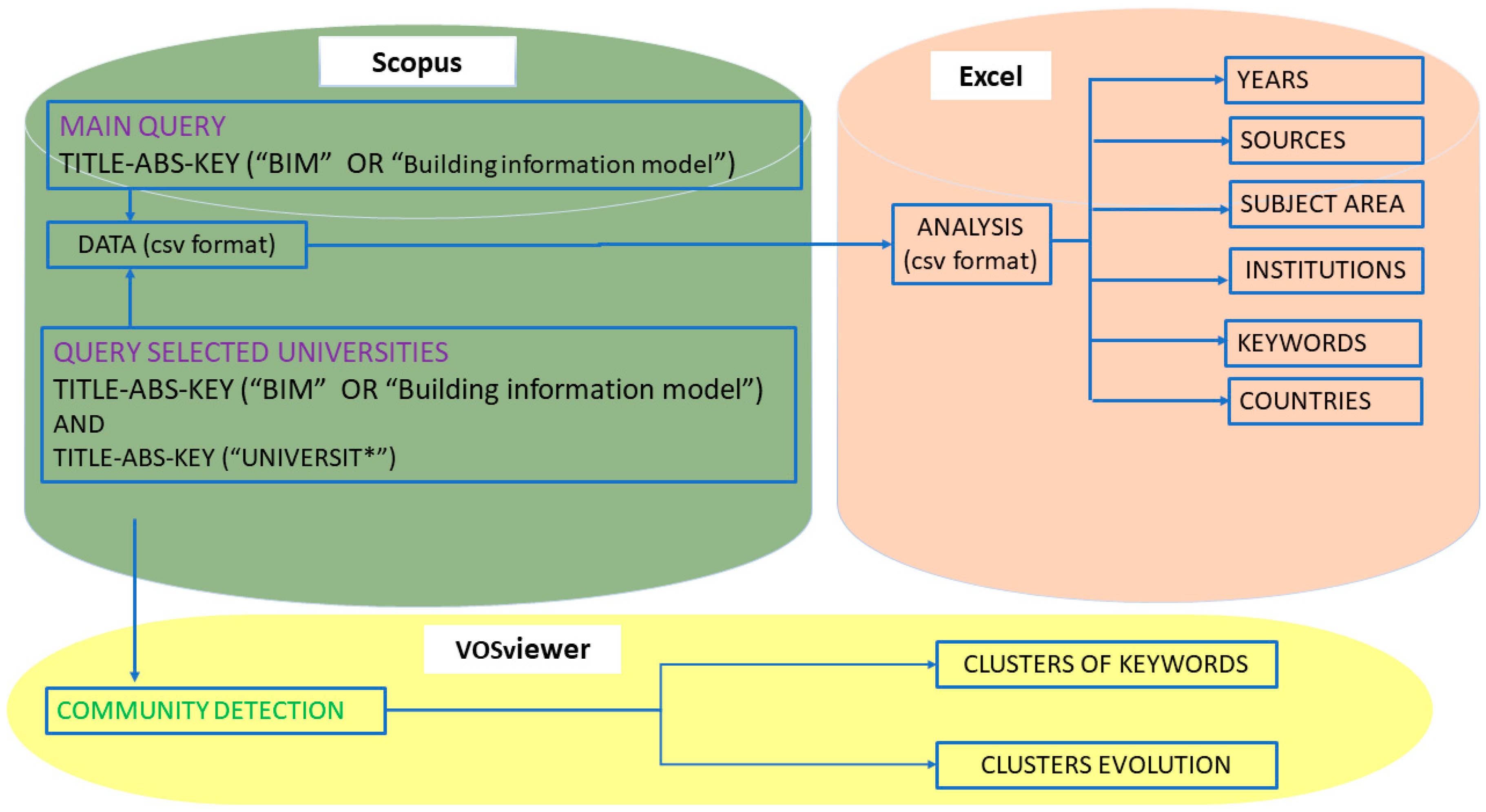
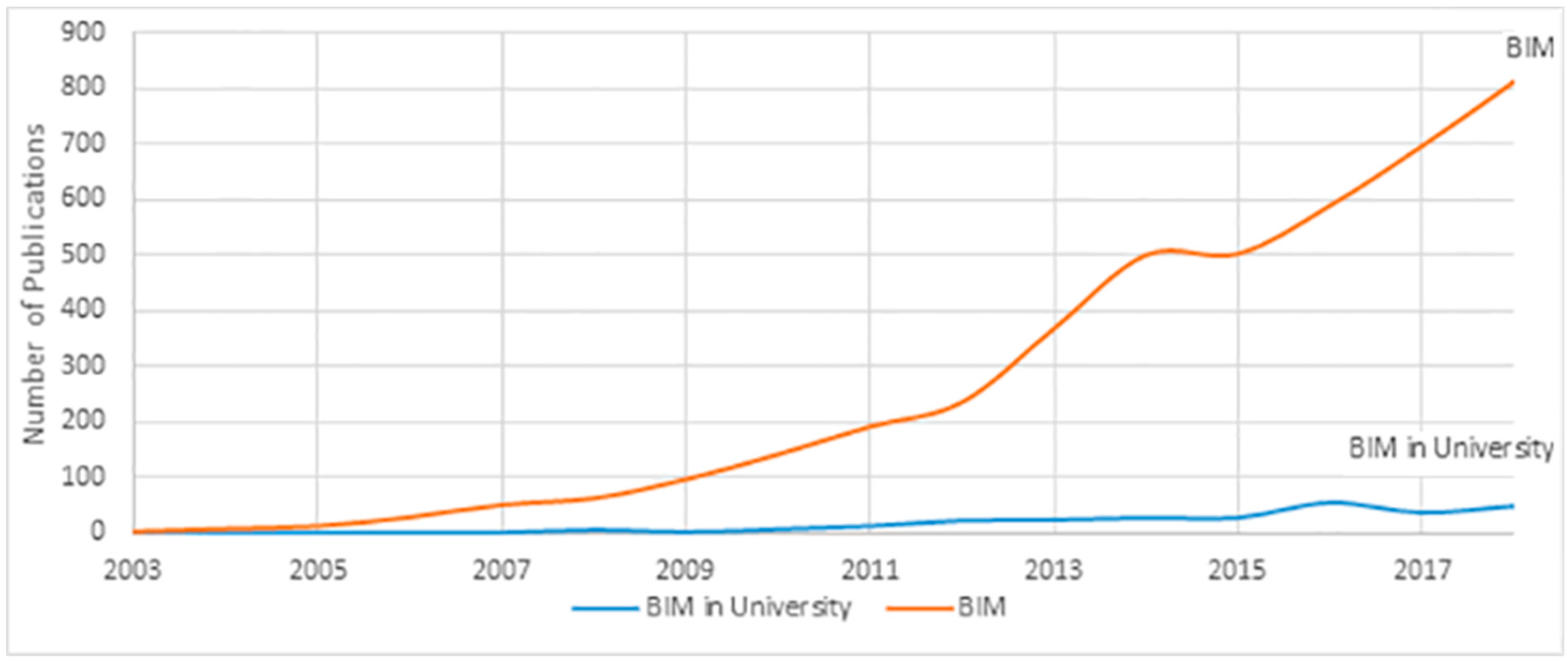
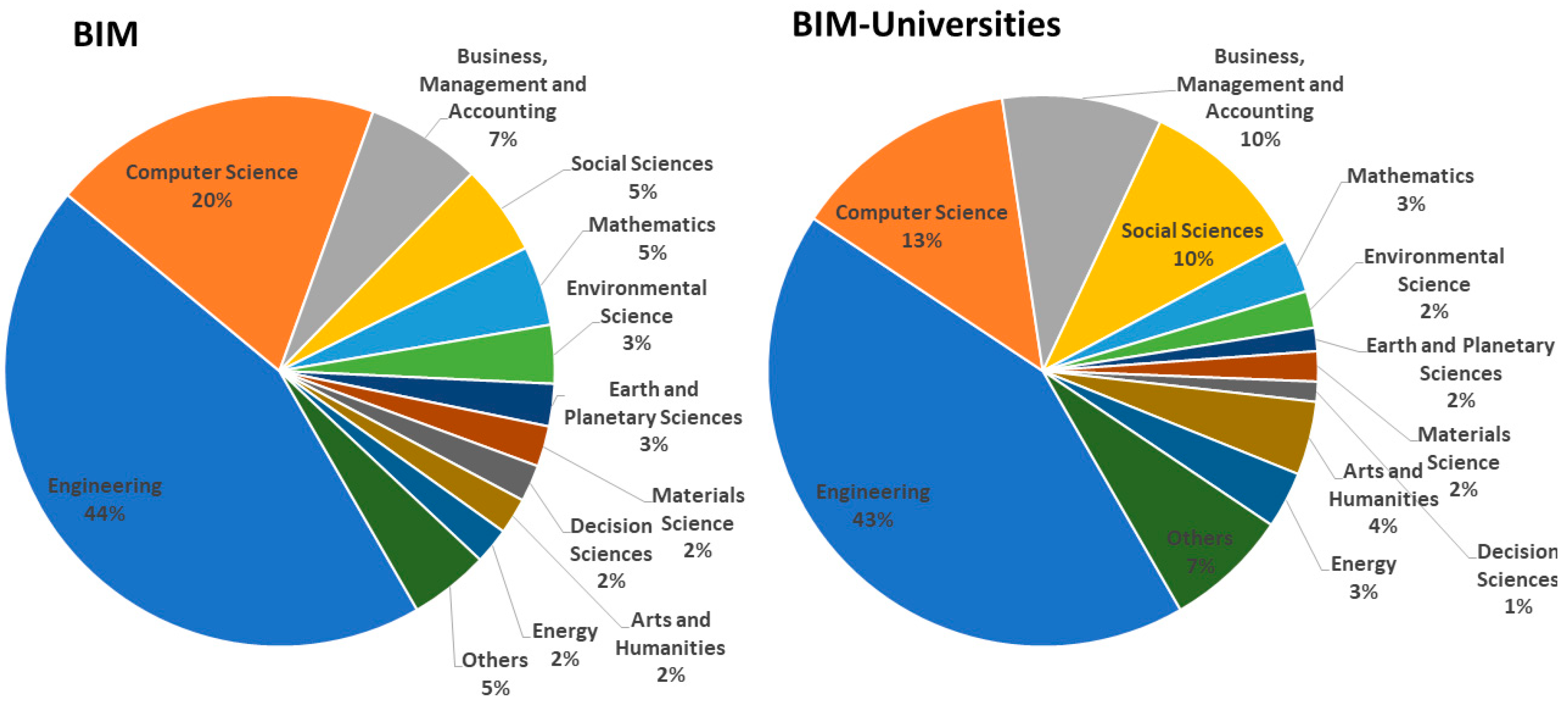
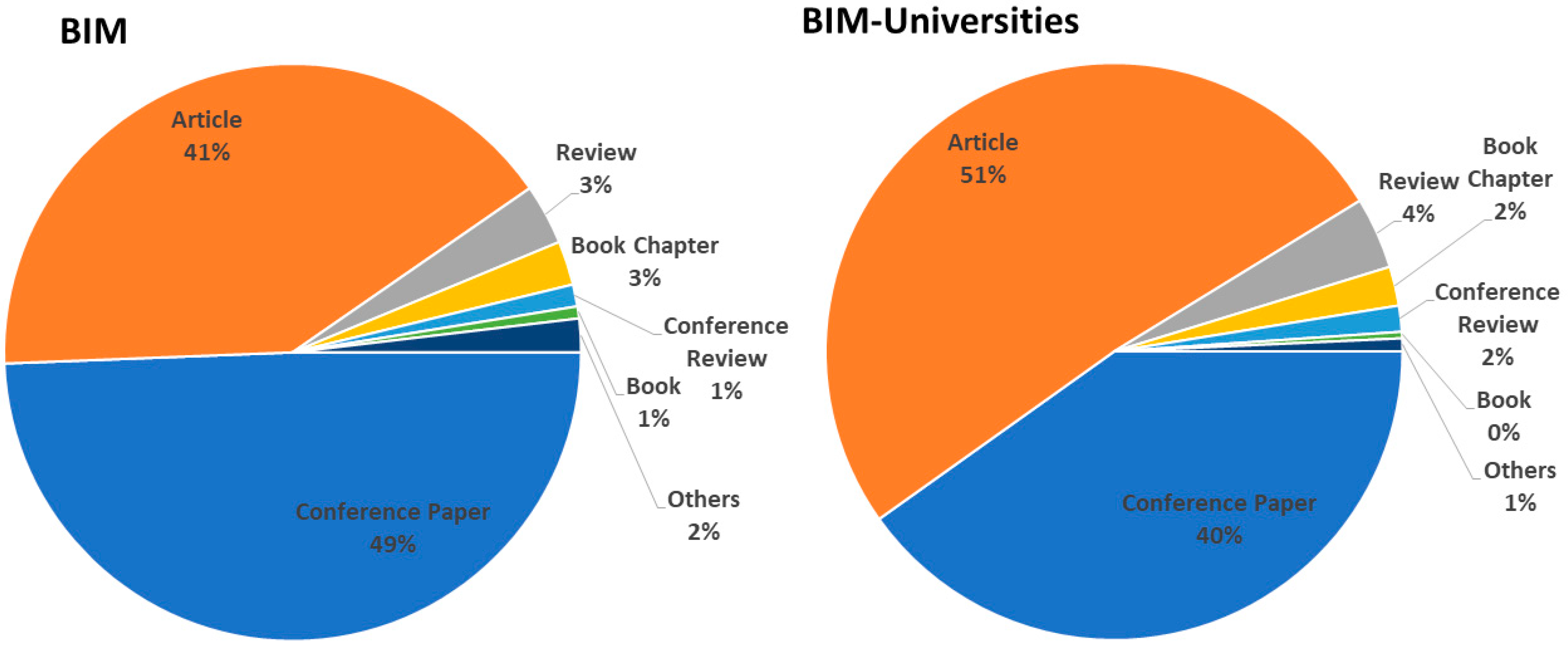
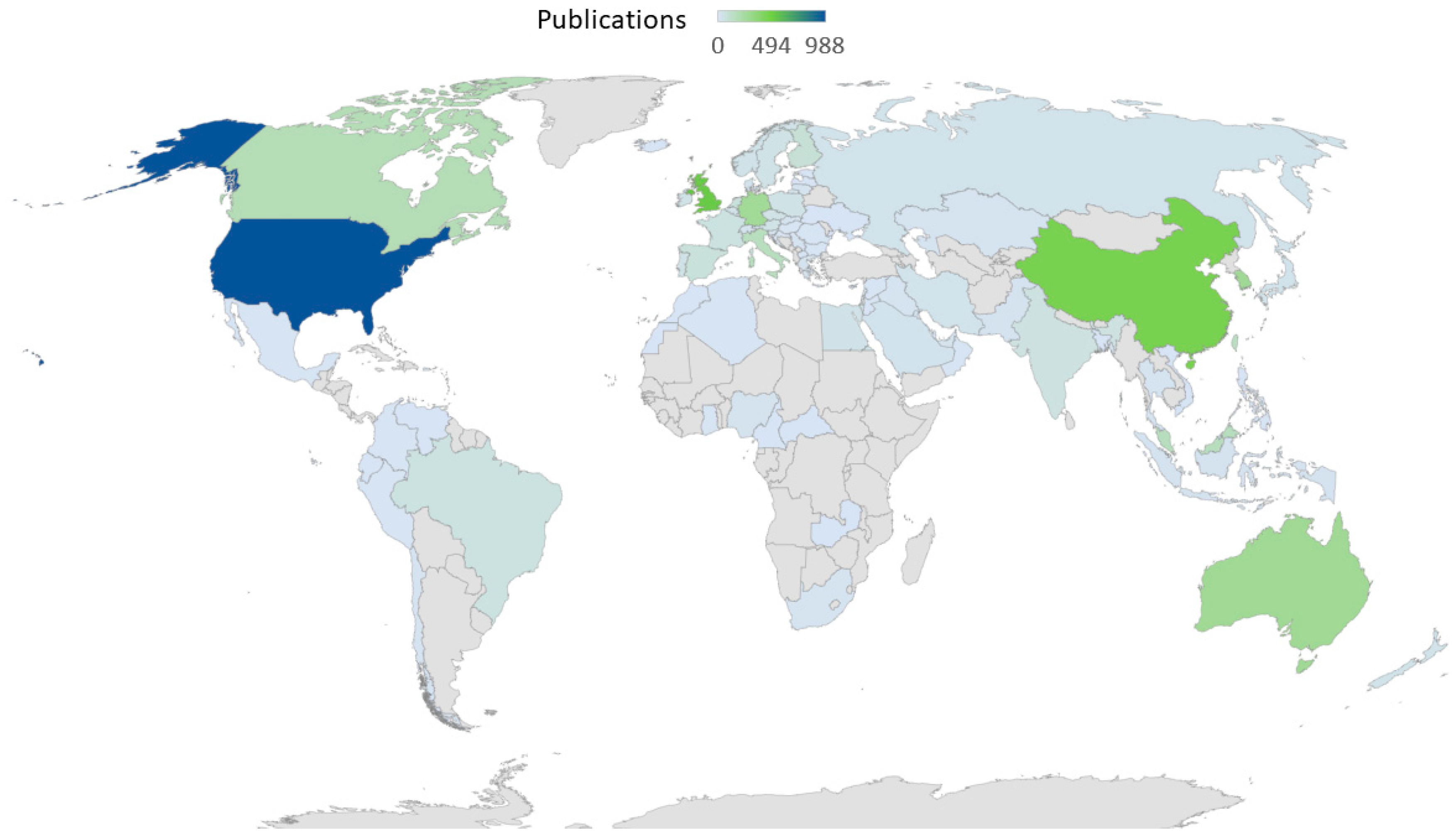
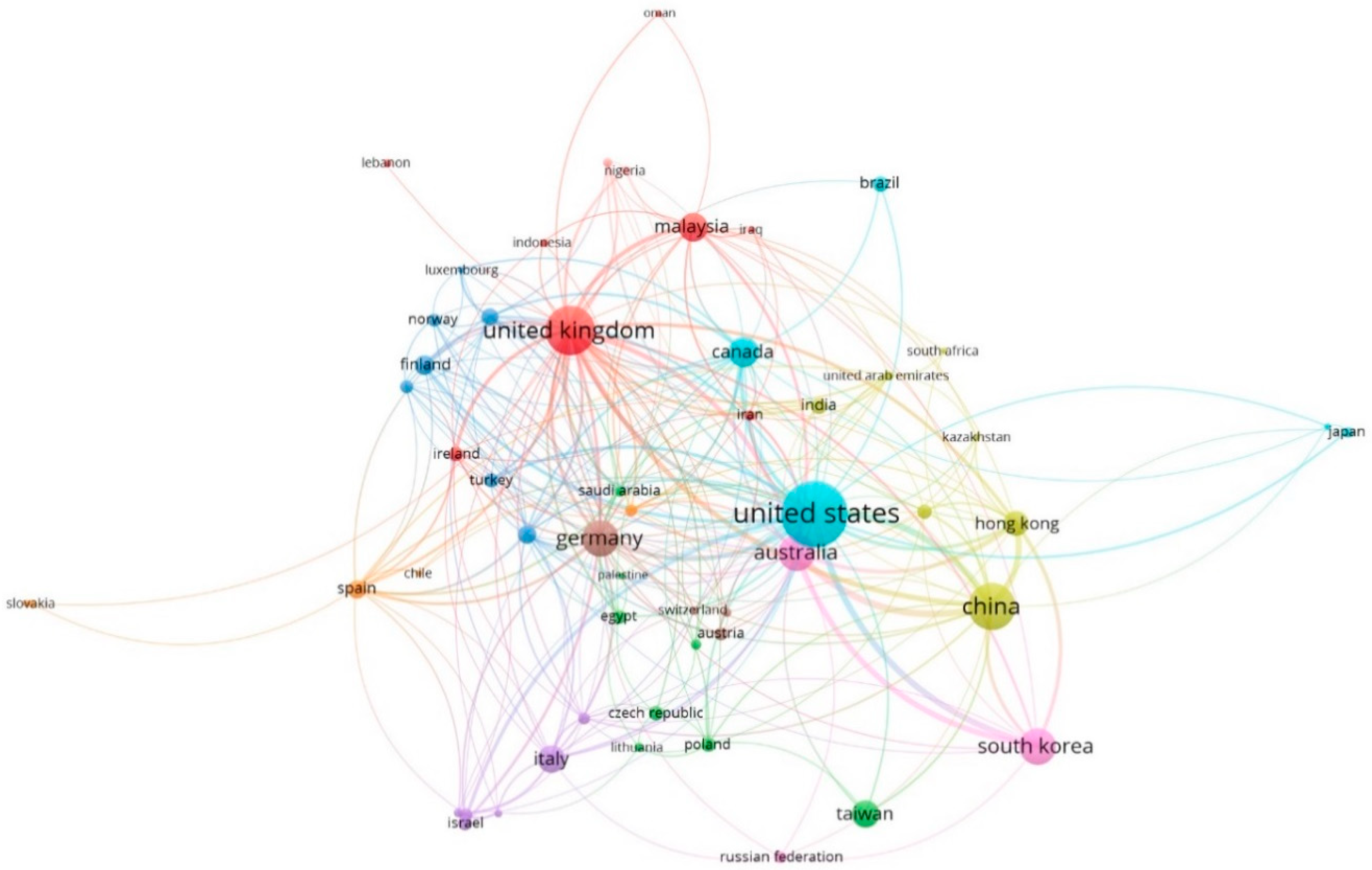
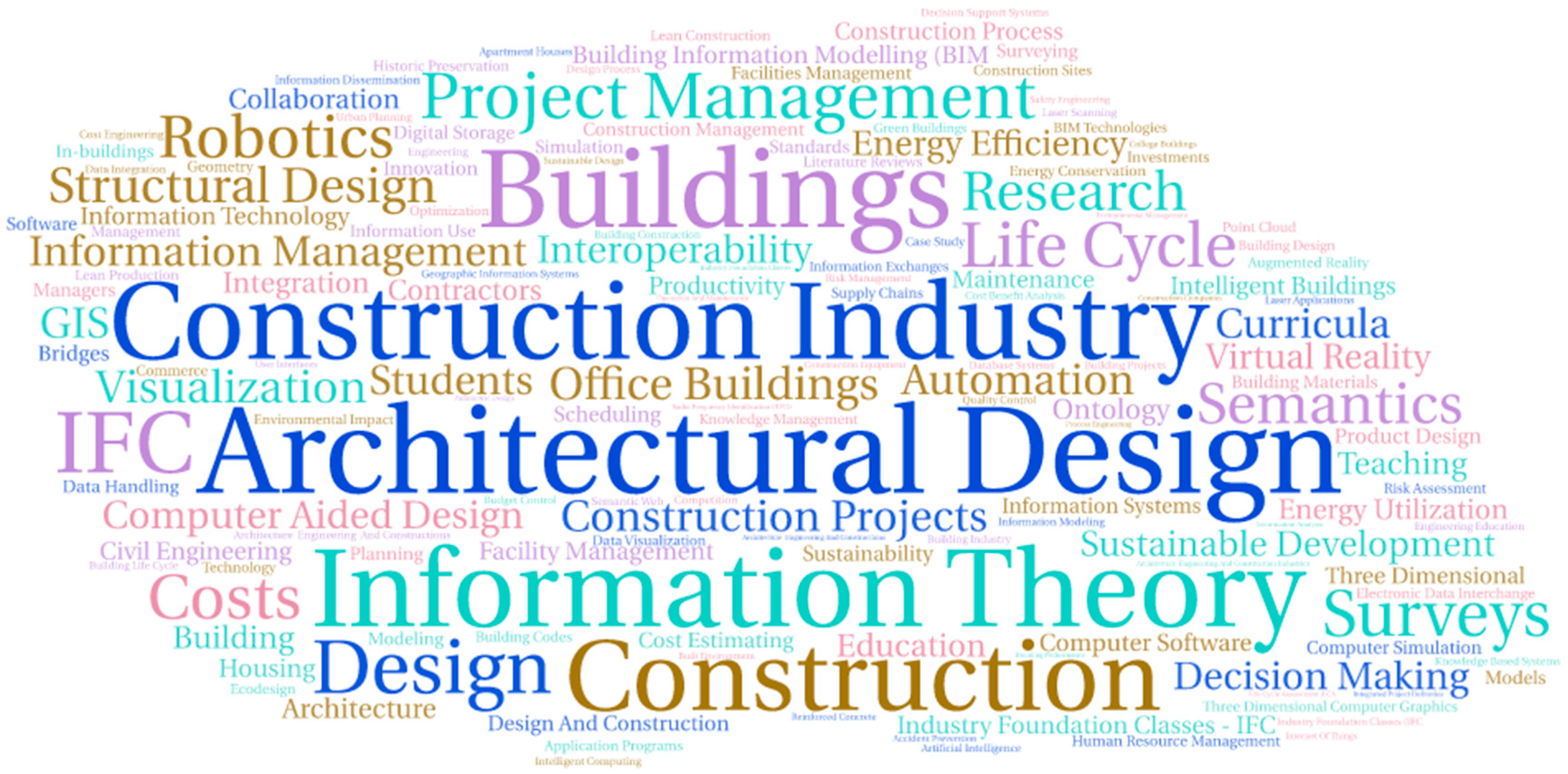
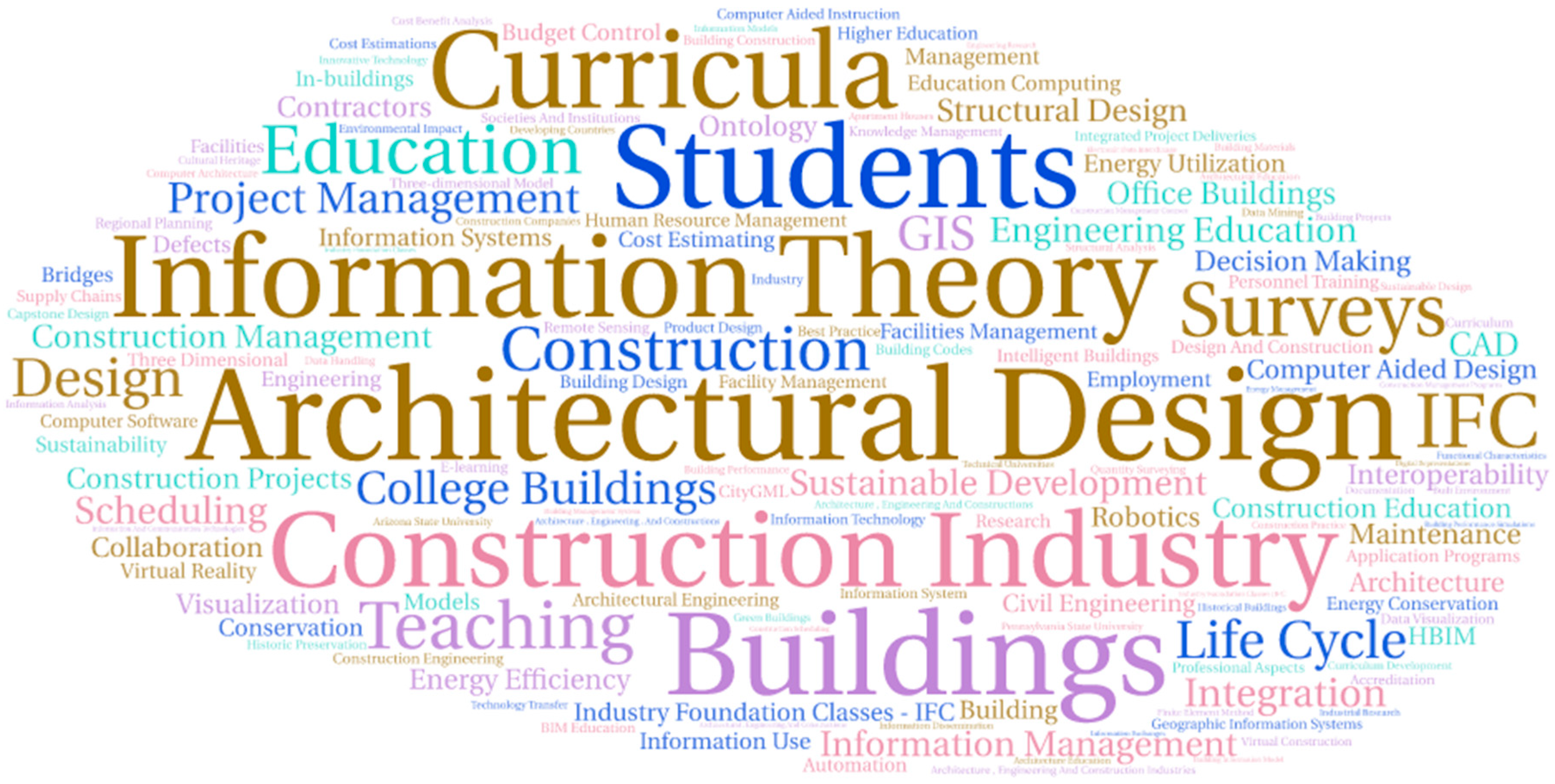
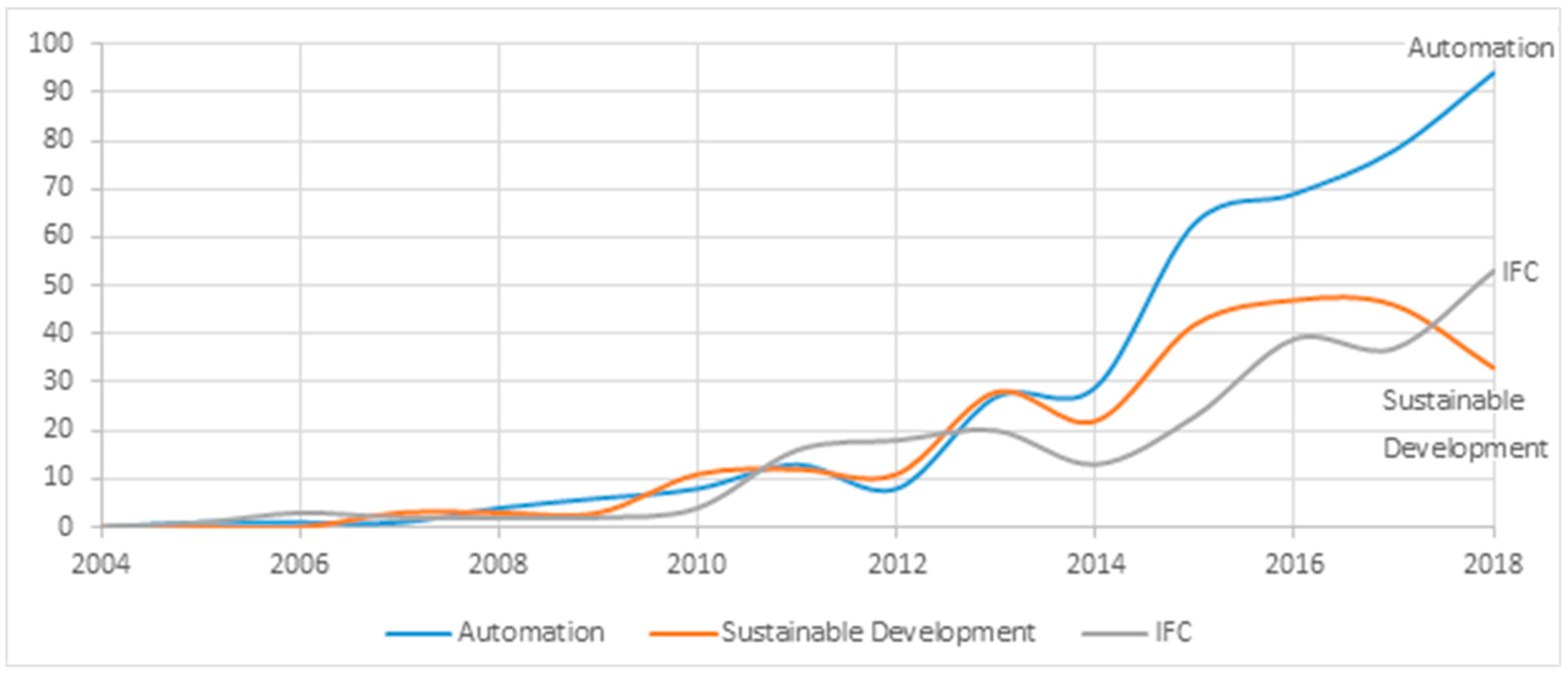
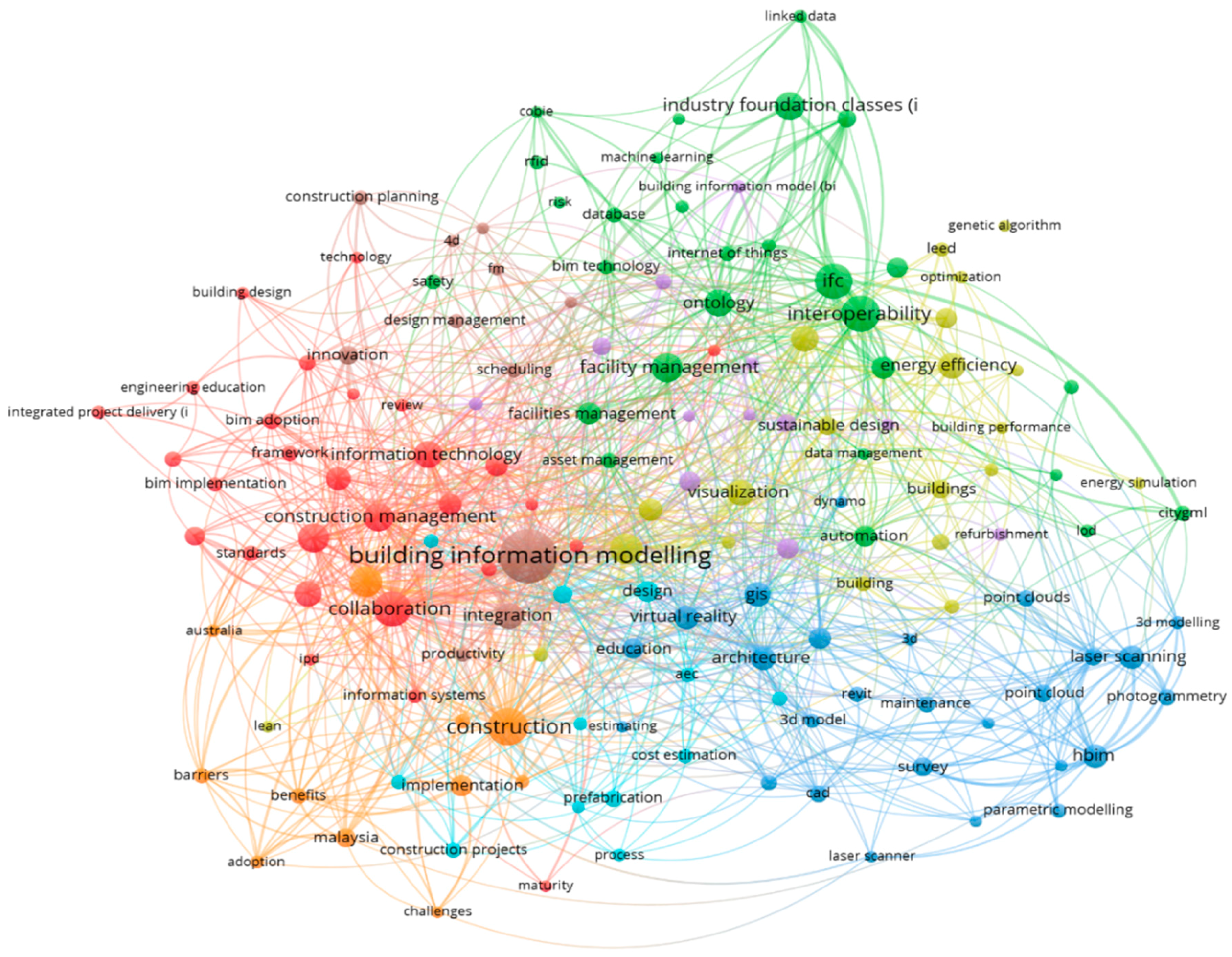
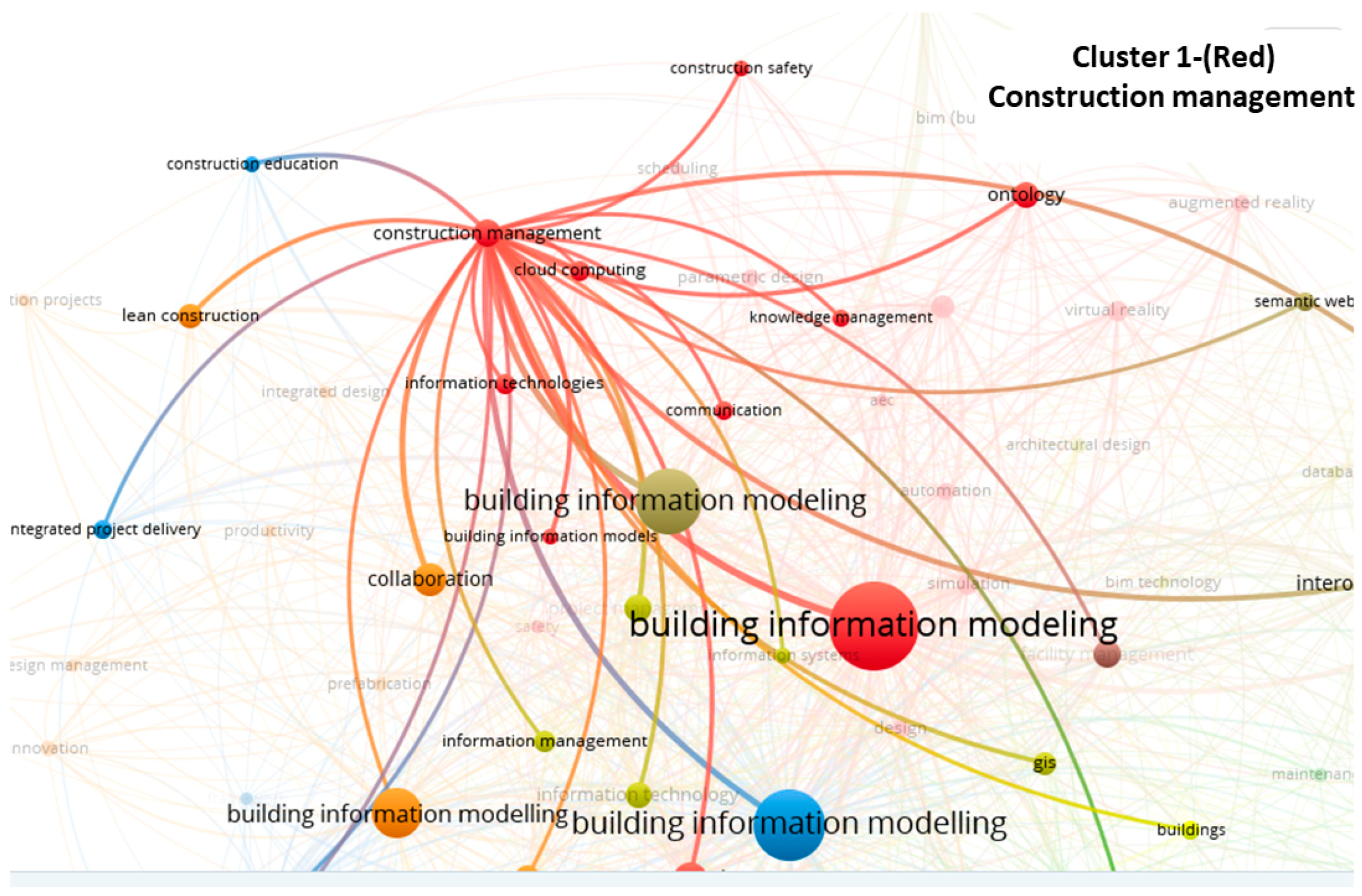
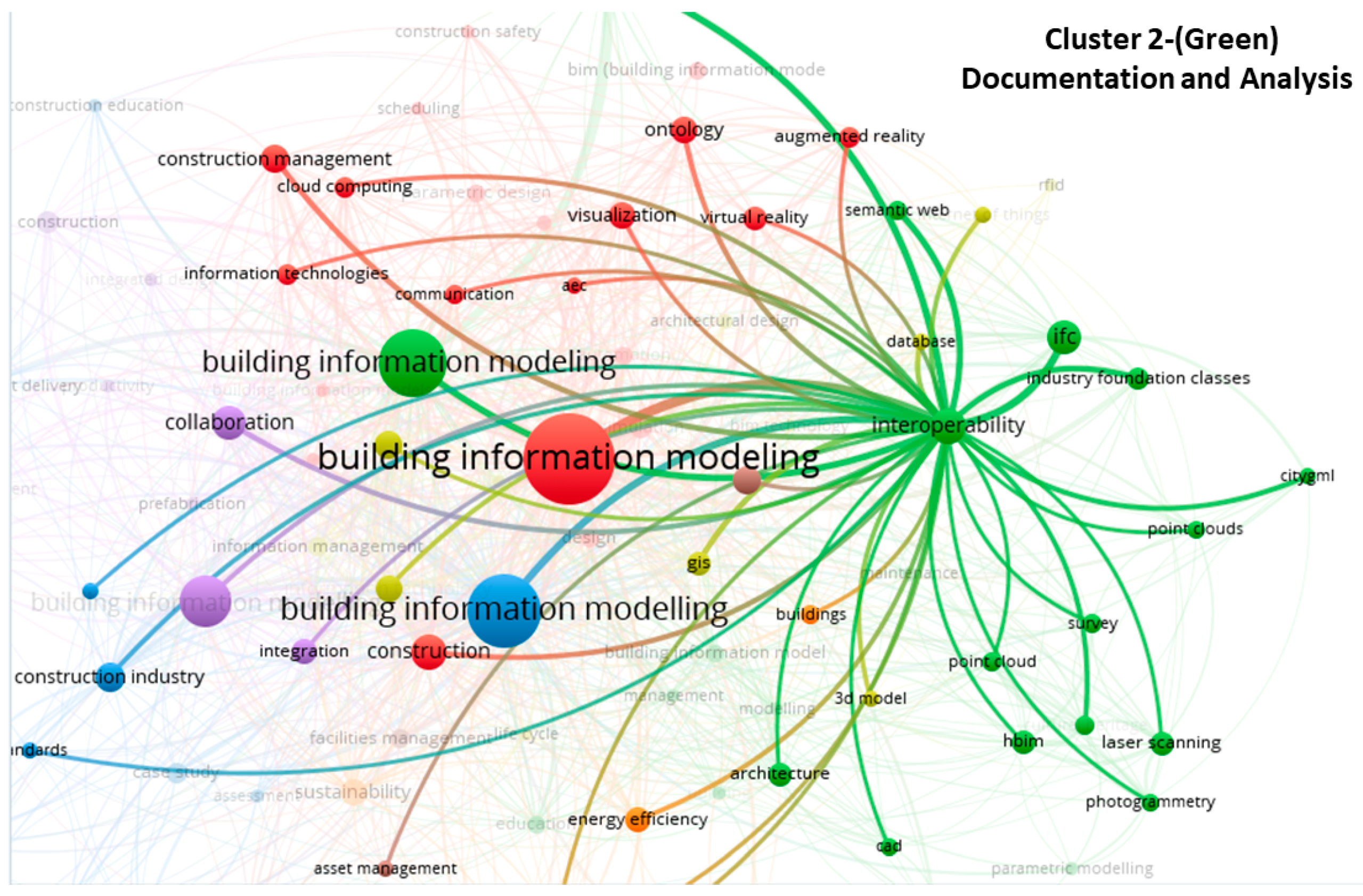
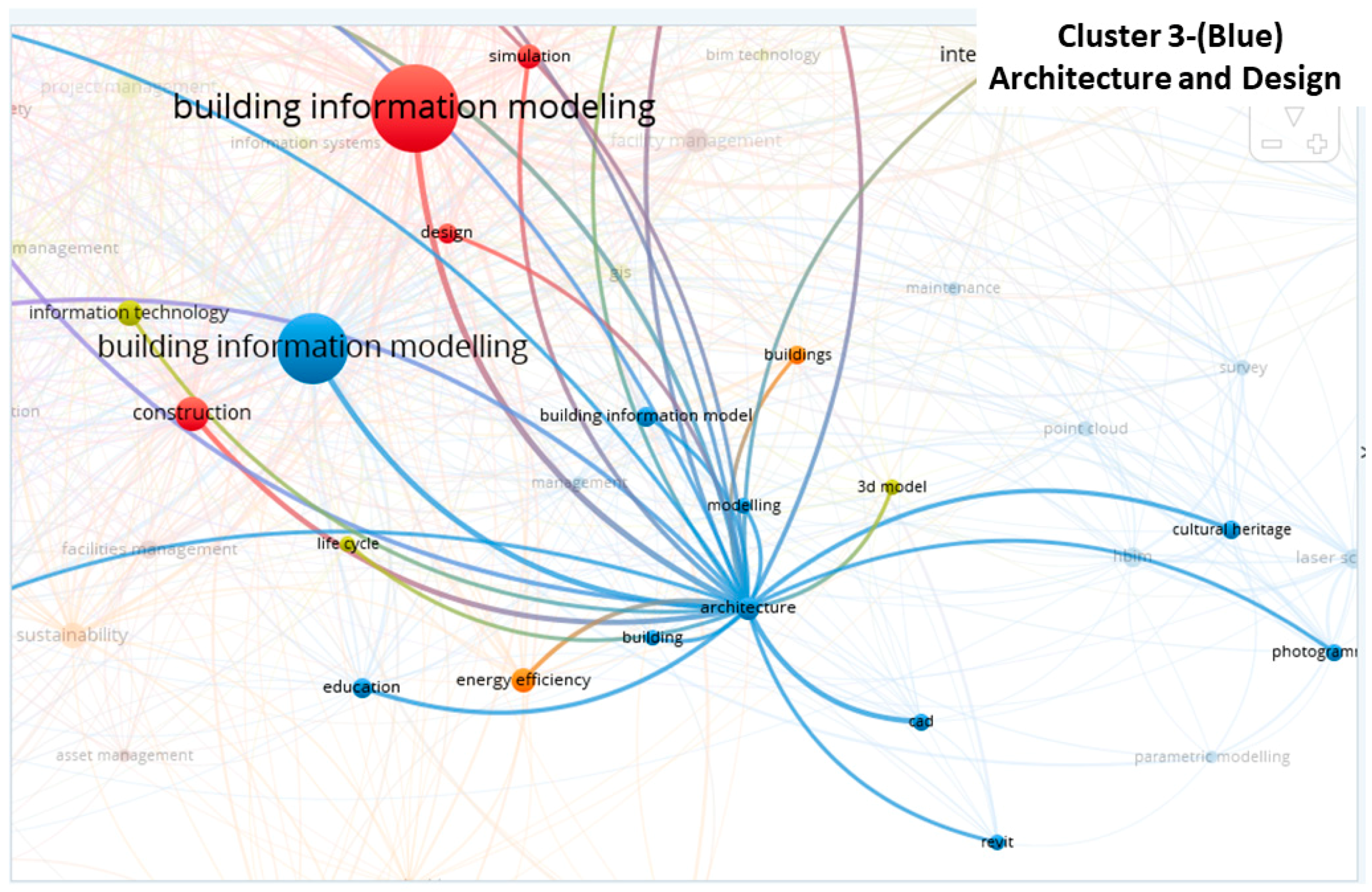
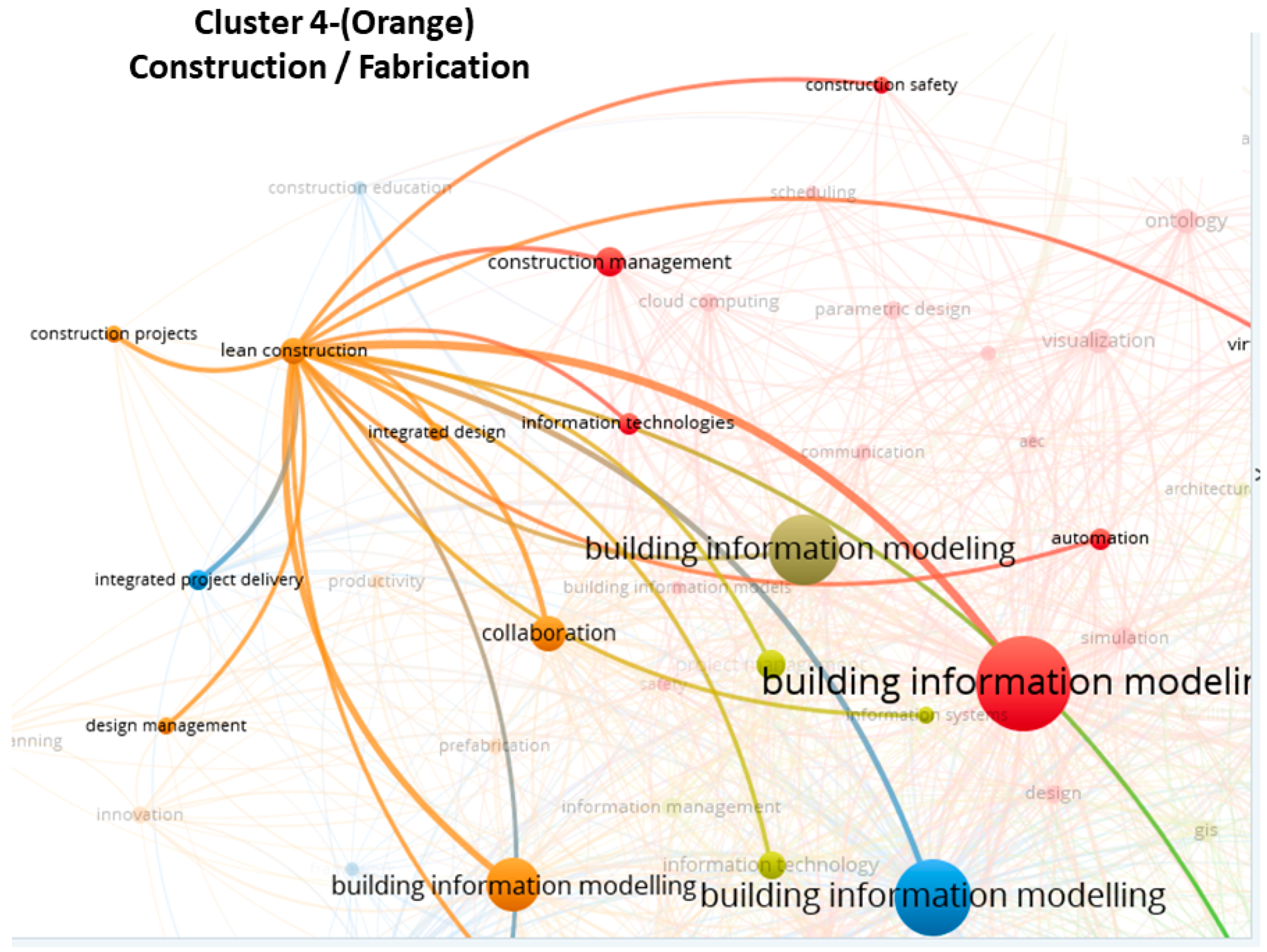
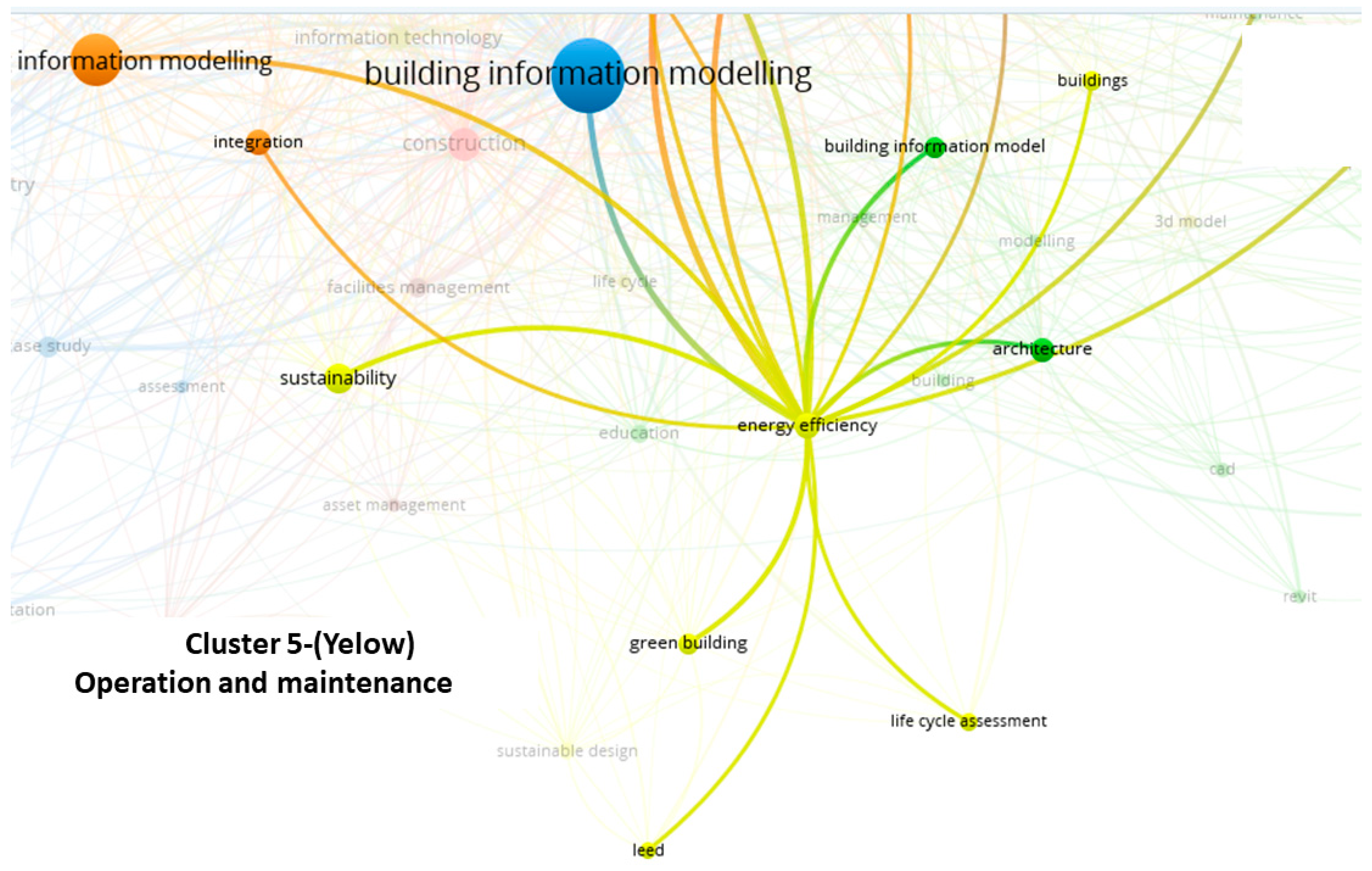

| BIM | BIM in University | ||||
|---|---|---|---|---|---|
| Affiliation | Country | N | Affiliation | Country | N |
| Georgia Institute of Technology | USA | 101 | Pennsylvania State University | USA | 9 |
| Curtin University | UK | 98 | Hong Kong Polytechnic University | China | 9 |
| University of Florida | USA | 93 | Tsinghua University | China | 8 |
| University of Salford | UK | 68 | Arizona State University | USA | 6 |
| Kyung Hee University | South Korea | 56 | Ceské vysoké ucení technické v Praze | Czech The Czech Republic | 5 |
| Pennsylvania State University | USA | 55 | National Taipei University of Technology | China | 4 |
| Hong Kong Polytechnic University | China | 54 | University of Southern California | USA | 4 |
| Politecnico di Milano | Italy | 49 | Vilniaus Gedimino technikos universitetas | Lithuania | 4 |
| Tongji University | China | 49 | Universidade de Lisboa | Portugal | 4 |
| Hanyang University | South Korea | 48 | Helsingin Yliopisto | Sweden | 3 |
| Universiti Teknologi Malaysia | Malaysia | 47 | University of Texas at San Antonio | USA | 3 |
| Cardiff University | UK | 46 | National Taiwan University | Taiwan | 3 |
| UCL (University College London) | UK | 43 | University of Salford | UK | 3 |
| Tsinghua University | China | 43 | University of Wyoming | USA | 3 |
| Technion—Israel Institute of Technology | Israel | 42 | Universitat d’Alacant | Spain | 3 |
| Technical University of Munich | Germany | 41 | International University of Florida | USA | 3 |
| BIM | N | BIM in Universities | N |
|---|---|---|---|
| Architectural Design | 3075 | Architectural Design | 168 |
| Information Theory | 1295 | Information Theory | 66 |
| Construction Industry | 935 | Construction Industry | 41 |
| Buildings | 671 | Students | 40 |
| Construction | 642 | Buildings | 39 |
| Project Management | 602 | Curricula | 38 |
| Information Management | 458 | Project Management | 37 |
| Structural Design | 458 | Teaching | 37 |
| Life Cycle | 377 | Construction | 35 |
| Construction Projects | 354 | Education | 35 |
| Sustainable Development | 291 | College Buildings | 34 |
| Office Buildings | 279 | Information Management | 30 |
| Design | 255 | Engineering Education | 27 |
| Computer Aided Design | 239 | Surveys | 20 |
| Decision Making | 224 | Life Cycle | 19 |
| Cluster | Color | Main Keywords | Topic |
|---|---|---|---|
| 1 | Red | Construction management —Collaboration –Information technology—Bim adoption | Construction management |
| 2 | Green | Interoperability-Facility management—Industry foundation classes —Internet of Things | Documentation and Analysis |
| 3 | Blue | Architecture—Virtual Reality—Education—GIS | Architecture and Design |
| 4 | Orange | Lean construction—Implementation—Adoption —Benefits | Construction/Fabrication |
| 5 | Yellow | Energy efficiency—sustainable design—Leadership in Energy and Environmental Design—energy simulation—Building performance | Operation and maintenance |
© 2019 by the authors. Licensee MDPI, Basel, Switzerland. This article is an open access article distributed under the terms and conditions of the Creative Commons Attribution (CC BY) license (http://creativecommons.org/licenses/by/4.0/).
Share and Cite
Chihib, M.; Salmerón-Manzano, E.; Novas, N.; Manzano-Agugliaro, F. Bibliometric Maps of BIM and BIM in Universities: A Comparative Analysis. Sustainability 2019, 11, 4398. https://doi.org/10.3390/su11164398
Chihib M, Salmerón-Manzano E, Novas N, Manzano-Agugliaro F. Bibliometric Maps of BIM and BIM in Universities: A Comparative Analysis. Sustainability. 2019; 11(16):4398. https://doi.org/10.3390/su11164398
Chicago/Turabian StyleChihib, Mehdi, Esther Salmerón-Manzano, Nuria Novas, and Francisco Manzano-Agugliaro. 2019. "Bibliometric Maps of BIM and BIM in Universities: A Comparative Analysis" Sustainability 11, no. 16: 4398. https://doi.org/10.3390/su11164398
APA StyleChihib, M., Salmerón-Manzano, E., Novas, N., & Manzano-Agugliaro, F. (2019). Bibliometric Maps of BIM and BIM in Universities: A Comparative Analysis. Sustainability, 11(16), 4398. https://doi.org/10.3390/su11164398








